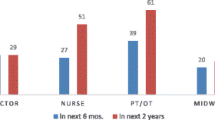Abstract
This paper proposes three measures of average exit time from catastrophic health payments; the first measure is non-normative in that the weights placed on catastrophic payments incurred by poor and nonpoor households are the same. It ignores the fact that the opportunity cost of health spending is different between poor and nonpoor households. The other two measures allow for distribution sensitivity but differ in their conceptualization of inequality; one is based on socioeconomic inequalities in catastrophic health payments, and the other uses pure inequalities in catastrophic health payments. The proposed measures are then applied to Malawian data from the Third Integrated Household Survey. The empirical results show that when the threshold of pre-payment income is increased from 5 to 15 %, the average exit time decreases from 2.1 to 0.2 years; and as the catastrophic threshold rises from 10 to 40 % of ability to pay, the average exit time falls from 3.6 to 0.1 years. It is found that adjusting for socioeconomic inequality leads to small changes in the exit times, however, using pure inequality leads to large reductions in the exit time.

Similar content being viewed by others
References
Government of Malawi (GOM). (2012). Malawi National Heath Accounts with subaccounts for HIV/AIDS, Malaria, Reproductive Health, and Child Health for Financial Years 2006/07, 2007/08, and 2008/09. Lilongwe, Malawi: Department of Health Planning and Policy Development.
Kakwani, N., Wagstaff, A., & Van Doorslaer, E. (1997). Socioeconomic inequalities in health: Measurement, computation, and statistical inference. Journal of Econometrics, 77(1), 87–103.
Morduch, J. (1998). Poverty, economic growth, and average exit time. Economics Letters, 59, 385–390.
O’Donnel, O., Van Doorslaer, E., Wagstaff, A., & Lindelow, M. (2008). Analyzing health equity using household survey data: A guide to techniques and their implementation. The World Bank: Washington, DC.
Pradhan, M., & Prescott, N. (2002). Social risk management options for medical care in Indonesia. Health Economics, 11, 431–446.
Ranson, M. K. (2002). Reduction of catastrophic health care expenditures by a community based health insurance scheme in Gujarat, India: Current experiences and challenges. Bulletin of the World Health Organisation, 80, 613–621.
Ruger, J. P. (2012). An alternative framework for analyzing financial protection in health. PLoS Medicine, 9(8), e1001294. doi:10.1371/journal.pmed.1001294.
Russell, S. (2004). The economic burden of illness for households in developing countries: A review of studies focusing on malaria, tuberculosis, and human immunodeficiency virus/acquired immunodeficiency syndrome. American Journal of Tropical Medicine and Hygiene, 71(Suppl. 2), 147–155.
Sen, A. K. (1976). Poverty: An ordinal approach to measurement. Econometrica, 44, 219–231.
Sparrow, R., van de Poel, E., Hadiwidjaja, G., Yumna, A., Warda, N., & Suryahadi, A. (2013). Coping with the economic consequences of ill health in Indonesia. Health Economics, 23, 719–728.
van Doorslaer, E., O’Donnell, O., Rannan-Eliya, R. P., et al. (2007). Catastrophic payments for health care in Asia. Health Economics, 16, 1159–1184.
Wagstaff, A. (2006). The economic consequences of health shocks: Evidence from Vietnam. Journal of Health Economics, 26, 82–100.
Wagstaff, A., & van Doorslaer, E. (2003). Catastrophe and impoverishment in paying for health care: With applications to Vietnam 1993–98. Health Economics, 12, 921–934.
Waters, H. R., Anderson, G. F., & Mays, J. (2004). Measuring financial protection in health in the United States. Health Policy, 69, 339–349.
Watts, H. W. (1968). An economic definition of poverty. In D.P. Moynihan (Ed.), On understanding poverty (pp. 316–329). New York: Basic Book.
World Bank. (2013). Malawi Public Expenditure Review, Report No. 79865-MW.
World Health Organization (WHO). (2000). World Health Report 2000. Geneva: World Health Organization.
World Health Organisation (WHO). (2005). Sustainable health financing, universal coverage and social health insurance. 115th World Health Assembly Resolution EB115.R13. Geneva: WHO.
World Health Organization (WHO). (2010). World health report: health systems financing: the path to universal coverage. Geneva: WHO.
Xu, K., Evans, D. E., Kawabate, K., et al. (2003). Household catastrophic health expenditure: A multicountry analysis. Lancet, 362, 111–117.
Author information
Authors and Affiliations
Corresponding author
Rights and permissions
About this article
Cite this article
Mussa, R. Exit from catastrophic health payments: a method and an application to Malawi. Int J Health Econ Manag. 16, 163–174 (2016). https://doi.org/10.1007/s10754-015-9184-y
Received:
Accepted:
Published:
Issue Date:
DOI: https://doi.org/10.1007/s10754-015-9184-y




